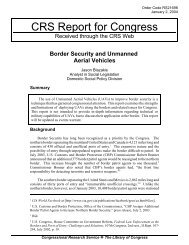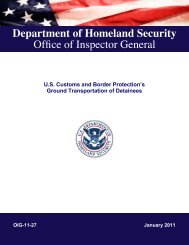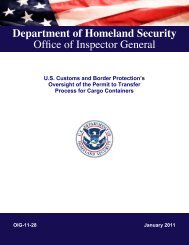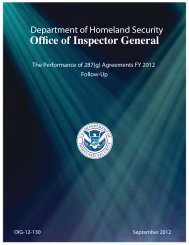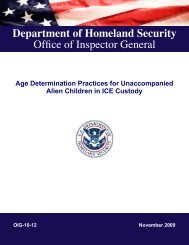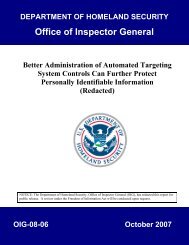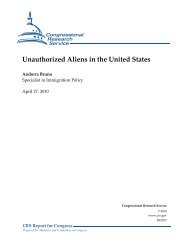Asylum and "Credible Fear" Issues in U.S. Immigration Policy
Asylum and "Credible Fear" Issues in U.S. Immigration Policy
Asylum and "Credible Fear" Issues in U.S. Immigration Policy
Create successful ePaper yourself
Turn your PDF publications into a flip-book with our unique Google optimized e-Paper software.
<strong>Asylum</strong> <strong>and</strong> “<strong>Credible</strong> Fear” <strong>Issues</strong> <strong>in</strong> U.S. <strong>Immigration</strong> <strong>Policy</strong>U.S. Government Accountability Office (GAO)The U.S. Government Accountability Office (GAO) analyzed the disparity <strong>in</strong> asylum decisions aswell <strong>and</strong> found that “significant variation existed.” GAO performed multivariate statisticalanalyses on asylum cases from 19 immigration courts that h<strong>and</strong>led almost 90% of the cases fromOctober 1994 through April 2007. GAO identified n<strong>in</strong>e factors that affected these outcomes:(1) filed affirmatively (orig<strong>in</strong>ally with DHS at his/her own <strong>in</strong>itiative) or defensively (withDOJ, if <strong>in</strong> removal proceed<strong>in</strong>gs); (2) applicant’s nationality; (3) time period of the asylumdecision; (4) representation; (5) applied with<strong>in</strong> 1 year of entry to the United States; (6)claimed dependents on the application; (7) had ever been deta<strong>in</strong>ed (defensive cases only); (8)gender of the immigration judge; <strong>and</strong> (9) length of experience as an immigration judge. 62GAO then statistically controlled for these n<strong>in</strong>e factors <strong>and</strong> found disparities across immigrationcourts <strong>and</strong> judges: “For example, affirmative applicants <strong>in</strong> San Francisco were still 12 times morelikely than those <strong>in</strong> Atlanta to be granted asylum. Further, <strong>in</strong> 14 of 19 immigration courts foraffirmative cases, <strong>and</strong> 13 of 19 for defensive cases, applicants were at least 4 times more likely tobe granted asylum if their cases were decided by the judge with the highest versus the lowestlikelihood of grant<strong>in</strong>g asylum <strong>in</strong> that court.” 63GAO also found that the grant rate for affirmative cases exceeded 50% for asylum seekers fromcountries such as Albania, the PRC, Ethiopia, Iran, Russia, Somalia, <strong>and</strong> the former Yugoslavia.In contrast, GAO found that the grant rate for affirmative cases was lower than 10% for asylumseekers from El Salvador, Guatemala, Honduras, <strong>and</strong> Mexico. In terms of defensive cases, GAOobserved that about 50% of asylum seekers from Iran <strong>and</strong> Ethiopia were granted asylum <strong>and</strong>almost 60% of such cases from Somalia were granted asylum. However, this outcome occurredfor 13% or less of the defensive asylum cases from El Salvador, Honduras, <strong>and</strong> Indonesia. 64 GAOalso offered the follow<strong>in</strong>g important caveat:Because data were not available on the facts, evidence, <strong>and</strong> testimony presented <strong>in</strong> eachasylum case, nor on immigration judges’ rationale for decid<strong>in</strong>g whether to grant or deny acase, we could not measure the effect of case merits on case outcomes. However, the size ofthe disparities <strong>in</strong> asylum grant rates creates a perception of unfairness <strong>in</strong> the asylumadjudication process with<strong>in</strong> the immigration court system. 65Transactional Records Access Clear<strong>in</strong>ghouse (TRAC)Researchers at Syracuse University’s TRAC have been conduct<strong>in</strong>g analyses of the immigrationcourts for several years <strong>and</strong> were among the earliest to identify wide variations <strong>in</strong> asylumoutcomes that were dependent on the immigration judge. “The typical judge-by-judge denialrate—half denied more <strong>and</strong> half denied less—was 65% . There were, however, eight judges who62 U.S. Government Accountability Office (GAO), U.S. <strong>Asylum</strong> System: Significant Variation Existed <strong>in</strong> <strong>Asylum</strong>Outcomes across <strong>Immigration</strong> Courts <strong>and</strong> Judges, GAO-08-940, September 2008, http://www.gao.gov/new.items/d08940.pdf.63 Ibid.64 Ibid.65 Ibid.Congressional Research Service 27



